What is a winter garden, rules and features of arrangement, types, design styles

During the cold season, there is a special craving for comfort and warmth. Creating a winter garden and extending summer for a whole year in your home today is not so difficult.
You can admire the greenery and lush flowering of exotic plants by equipping a special room with an optimal microclimate for plants.
However, not everyone knows what a winter garden is and how to properly equip it.
Content:
- What is a winter garden, description, types
- Winter garden project
- Design styles
- Rules for arranging a winter garden in a private house
- What materials are used for construction
- Organization of heating and ventilation
- Lighting
- What plants are recommended to grow in the winter garden
What is a winter garden, description, types
A winter garden is a separate heated extension, or part of the house, the main purpose of which is to create optimal conditions for maintaining optimal conditions for the life of a variety of (mainly tropical) plants.
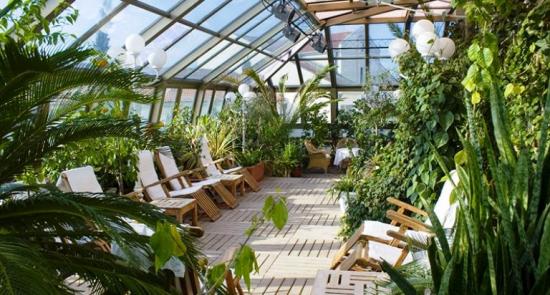
In addition, it can be used as a relaxation area.
Depending on the features of construction and purpose, there are three types of winter gardens:
- Residential, settles down in a house with constant heating. Thanks to properly selected microclimate conditions, both plants and people coexist perfectly in its conditions;
- Greenhouse, a room with ideal conditions for growing plants.Since some exotic species require certain conditions of temperature and humidity, a person will hardly be able to rest in such conditions;
- Buffer unheated, equipped for aesthetic purposes. Since the room has a door opening onto the street, it is impossible to ensure a constant microclimate here; this is a kind of buffer zone between the house and the street with a small number of crops.
Depending on what they want to see in the end, they first decide on the view. The next stage is the creation of the project.
Winter garden project
One of the main stages of the construction of each building is the creation of a project. The garden is no exception, since here you will also have to decide on the construction site, type of structure and other details.
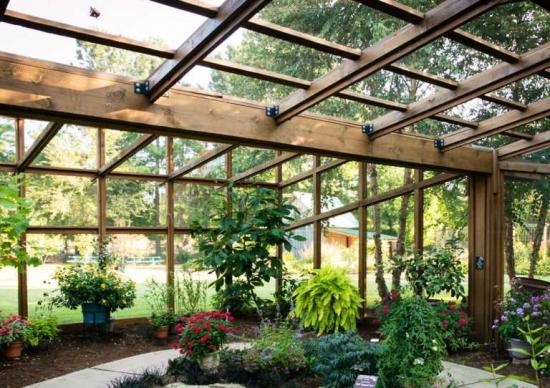
At the design stage, a plan for the location of the building is drawn up, the amount of materials and possible expenses are calculated. Ideally, it is better to entrust this to a specialist, since an incorrectly constructed plan can lead to problems in further construction and the purchase of material.
It is at this stage that it is important to take into account all the details of the desired result. This is not only the arrangement of the extension, but also the provision of heating, if necessary.
We invite you to watch an interesting video about what a winter garden is and familiarize yourself with the principles of its creation:
Design styles
Garden decoration is also of great importance, which will look much more impressive if it is subordinated to one specific style.

Depending on the combination of elements, styles are distinguished:
- English is often represented by a five-slope or gable transparent structure. The main colors are white, cream, not bright pink and green.Particular attention is paid to the windows, which are decorated with a variety of vintage elements and curtains;
- Country, or rustic, is distinguished by bright and lush flower beds, sometimes even vegetables. Sometimes they are decorated with rural utensils and wooden furniture;
- Classic is distinguished by neutral, warm tones in the decoration. The plants are subtropical; a mini-fountain or other water reservoir is often located in the center;
- Modernism is distinguished by laconicism and contrast, smooth and clear outlines. Plants are predominantly large and succulent, such as lilies and peonies;
- The Mediterranean is distinguished by its simplicity and clear lines; it is often a lean-to structure adjacent to the house. Light colors predominate; forged benches and antique statues can be used as decoration. Traditional plants roses, palms, junipers, rosemary, saffron;
- Japanese minimalist style with strong symbolism. It is divided into: kare-sansui with an abundance of gravel, stones and sand, without plants; tsukiyama hilly garden with dwarf trees, rocky mounds and a small pond; place for tea ceremonies.
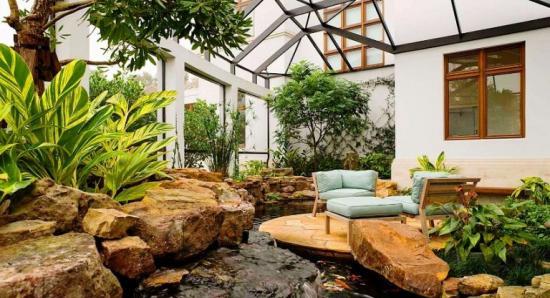
Depending on the chosen style, the design features of the building differ.
The combination of a large number of decorative details and the correct selection of plants makes the style expressive.
Rules for arranging a winter garden in a private house
When arranging such a corner in a private home, it is important to take into account a number of points that we recommend paying attention to.
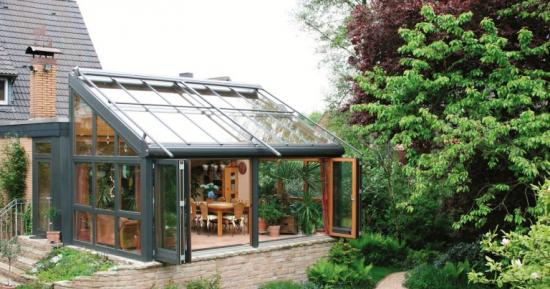
These include:
- Providing enough light;
- Maintaining a constant temperature;
- Maintaining the required air humidity;
- Construction of a sufficiently strong and airtight frame;
- Maintain constant air circulation.
The main goal of the arrangement should remain the creation of an optimal microclimate. Only by taking these points into account will it be possible to equip a building that is sufficiently protected from negative environmental conditions.
Let's watch a useful video about the proper arrangement of a winter garden in your own home:
What materials are used for construction
In order for the plants to receive a sufficient amount of sunlight and heat, it is recommended to make the building as light as possible.
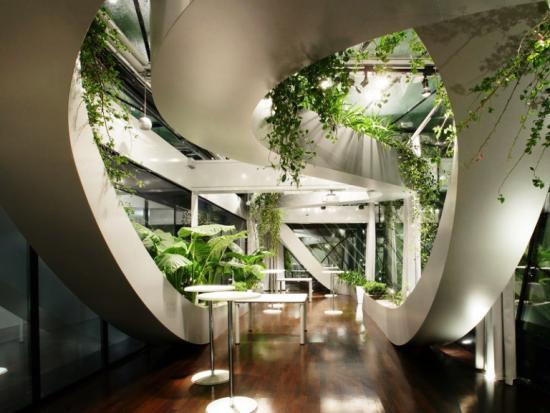
The most common materials adapted for this include:
- Glass is durable and transparent, but can crack from a strong impact and is expensive;
- Polycarbonate is moisture resistant, flexible and inexpensive. However, light transmits worse than glass and retains heat poorly;
- Double-glazed windows are quite an expensive material with a lot of weight, but in terms of light transmission and thermal insulation they significantly outperform both glass and polycarbonate;
- Plexiglas is a fairly heavy material, which is often used in combination with other materials for the construction of side walls.
It is recommended to choose material based on the desired results and financial capabilities/
Organization of heating and ventilation
Choosing the right material is half the battle.
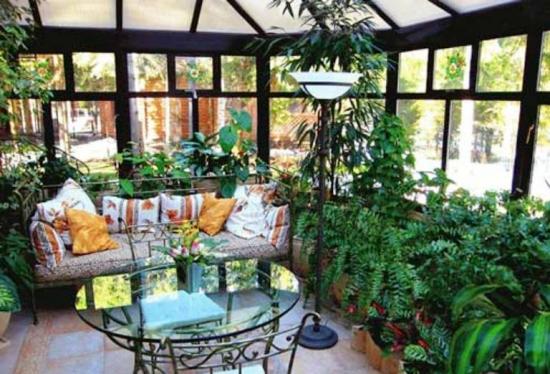
In winter, the heat will still not be enough and for this you need to take care of heating:
- Water heating with the connection of the building to the house heating system with the installation of radiators;
- The stove is characterized by uneven heat distribution;
- Split systems
- Warm floor (water or electric);
- UFOs are suitable for small kindergartens;
- Electric heaters.
Another problem worth paying attention to is the ventilation system.
In this case, you will have to choose between natural ventilation, provided by vents, and mechanical ventilation, which is provided by fans.
Lighting
In addition to heating, in winter the room needs additional lighting.
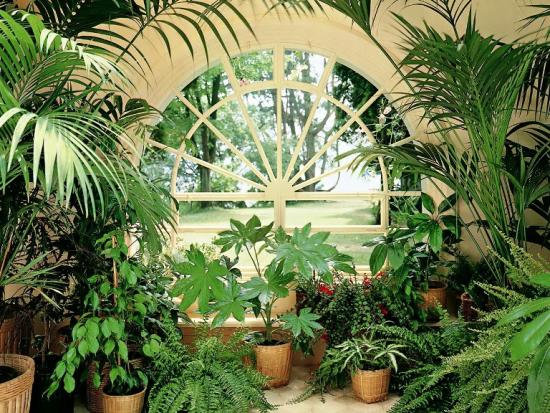
You can provide lighting using:
- Incandescent lamps with spectral rays of 600 nm;
- Fluorescent lamps;
- Metal halide lamps;
- Sodium lamps;
- High pressure mercury lamps;
- LED lamps.
In addition, there are phyto-lamps that are specially adapted for use in greenhouses and winter gardens. This is one of the most expensive, but optimal lighting options.
What plants are recommended to grow in the winter garden
When choosing plants, they are guided by their taste. However, if you are combining two types, it is important to carefully approach the issue of their combination. So desert plants will not feel comfortable in the conditions in which tropical species grow.
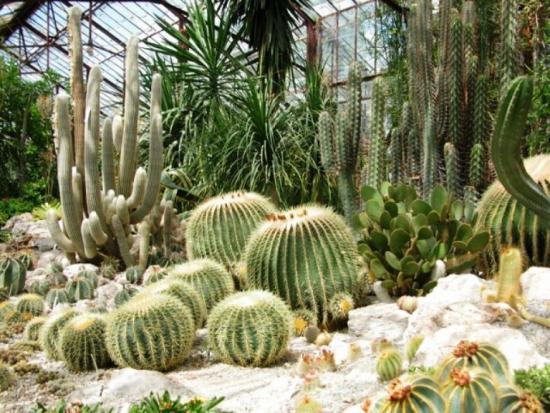
For growing in a winter garden, it is recommended to select low-growing species with approximately the same requirements for environmental conditions.
In this case, the danger of pleasing one plant and destroying the second is minimized.
A winter garden is a separate room, or adjacent to the house, with an optimal microclimate for plants. It is used both purely for growing plants and as a place to relax.

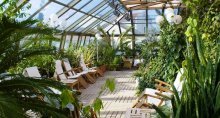

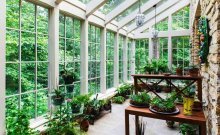
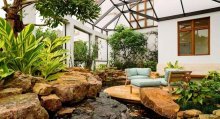
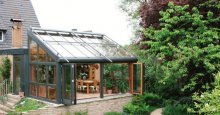
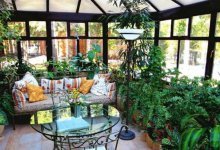
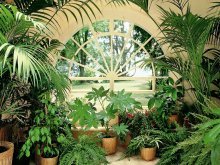
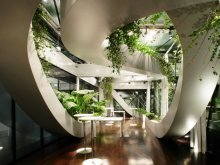

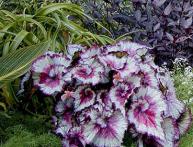
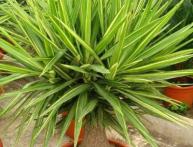
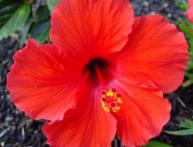
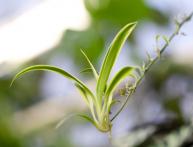

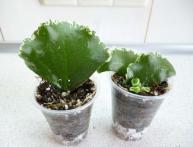

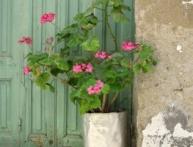
Comments
In my opinion, one of the best options for a winter garden is an extension to the house, which is located on the south side. In such a winter garden there will always be a lot of sun, and the building will block it from the northern winds. The frame of the winter garden can be made from a profile for plastic windows, and the window fillings themselves can be made from double-glazed windows.